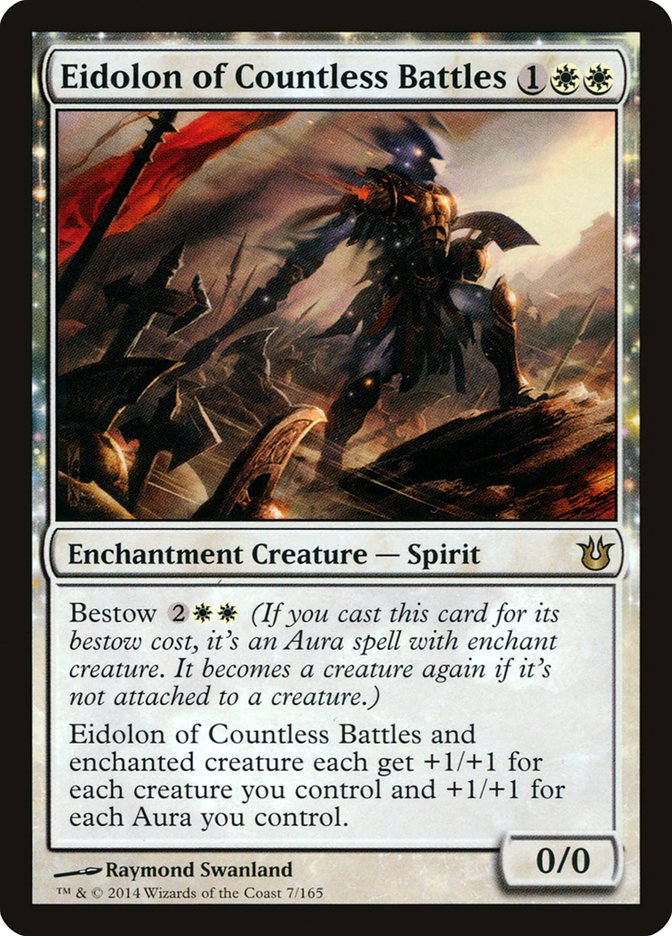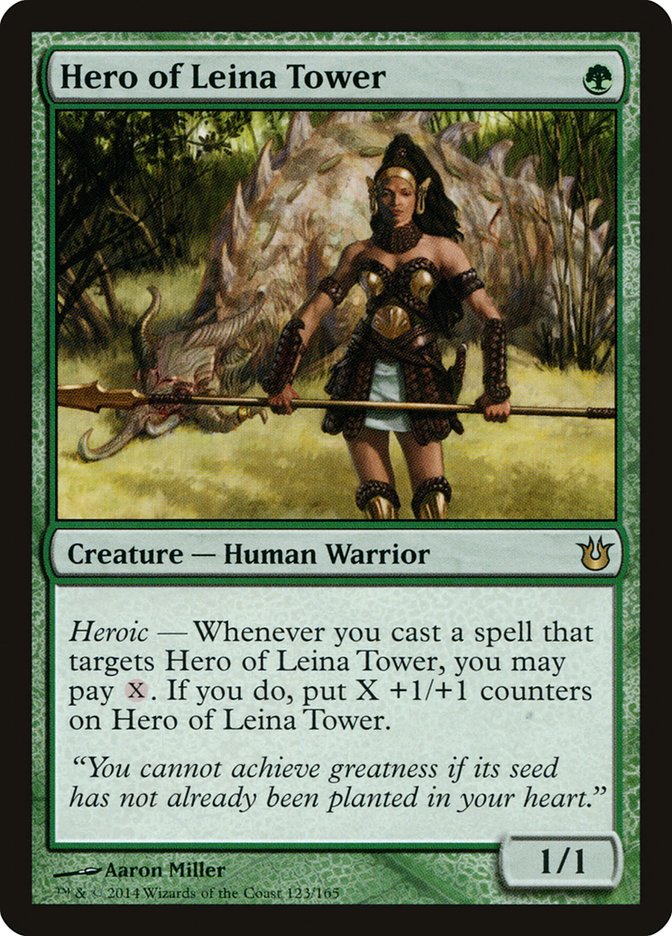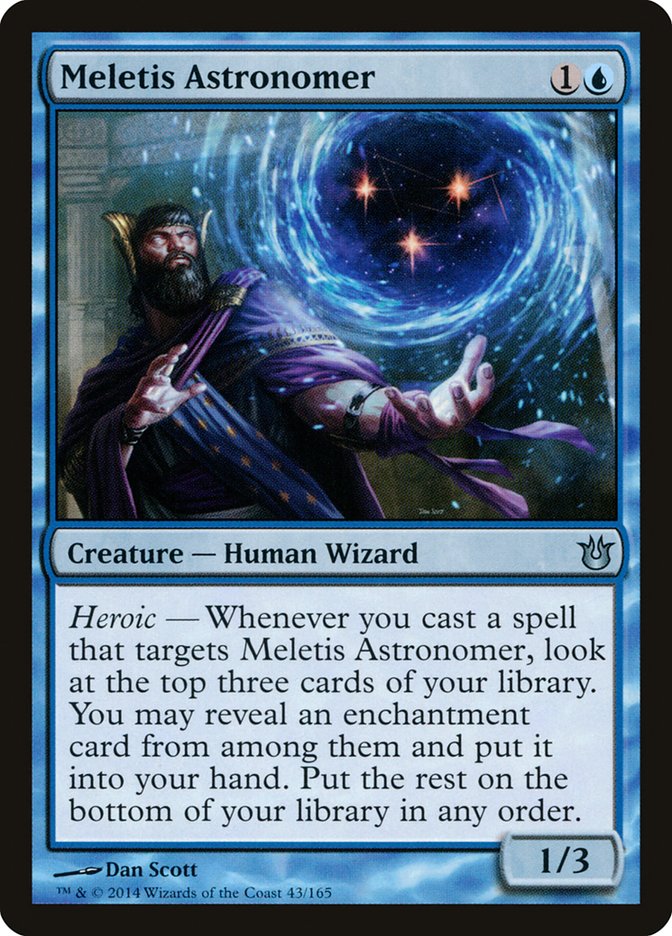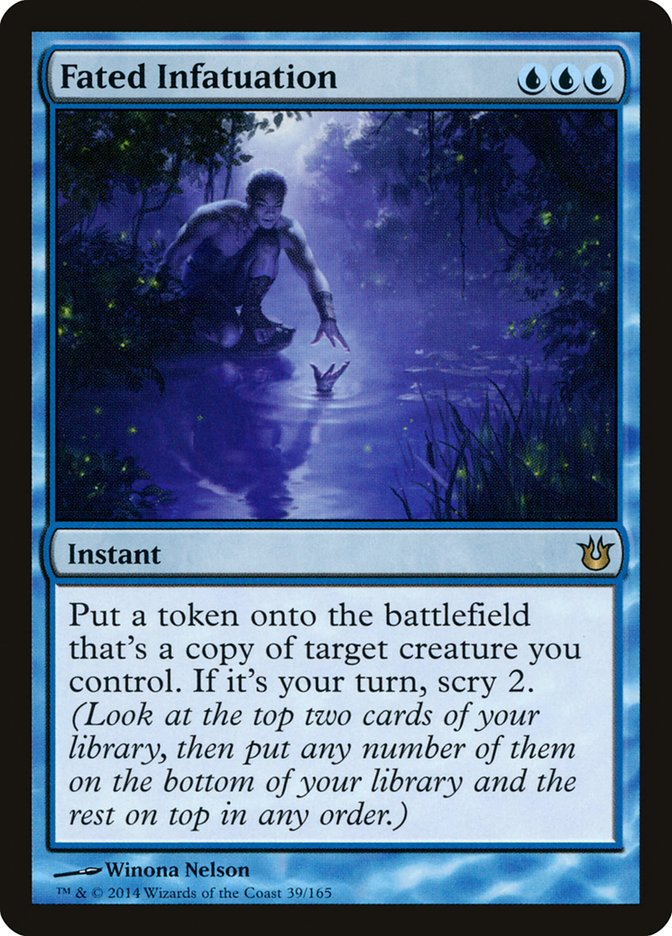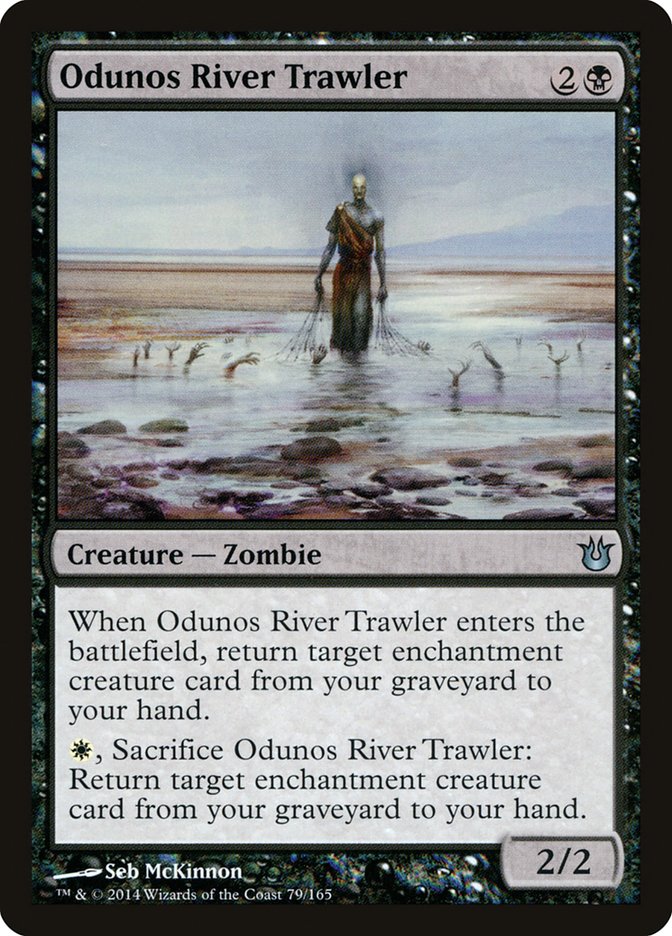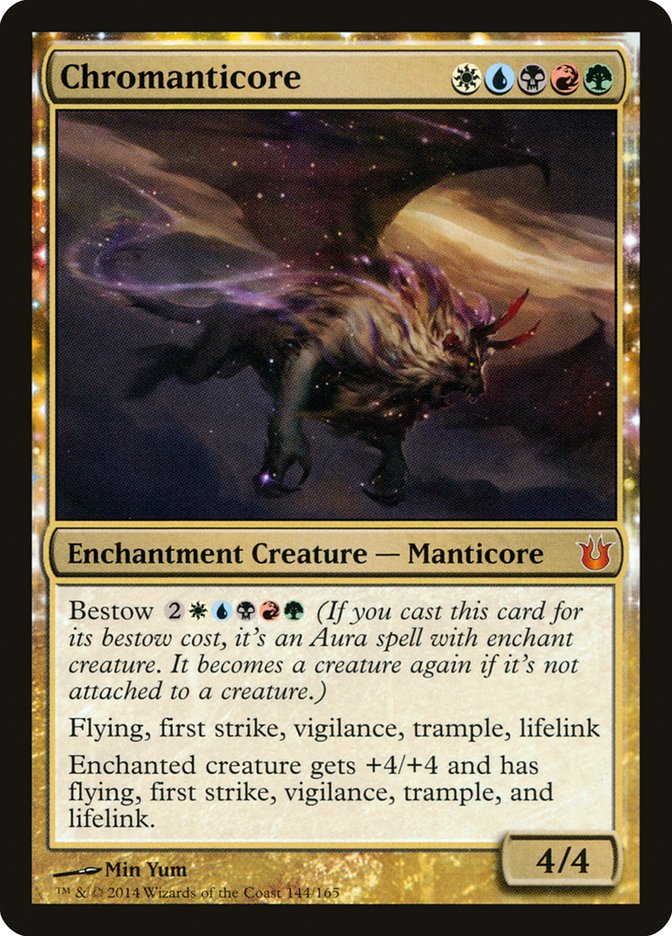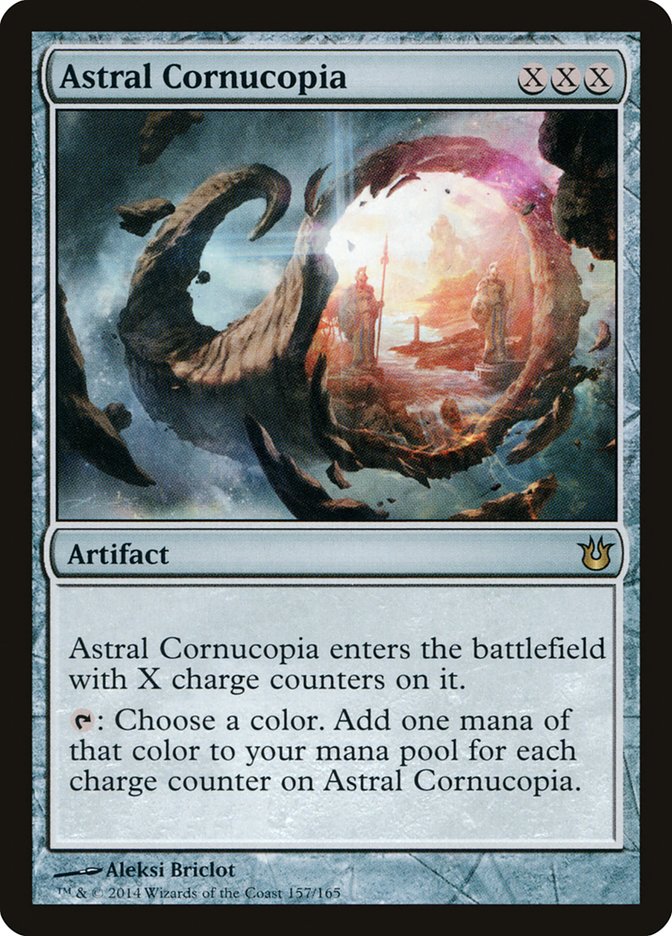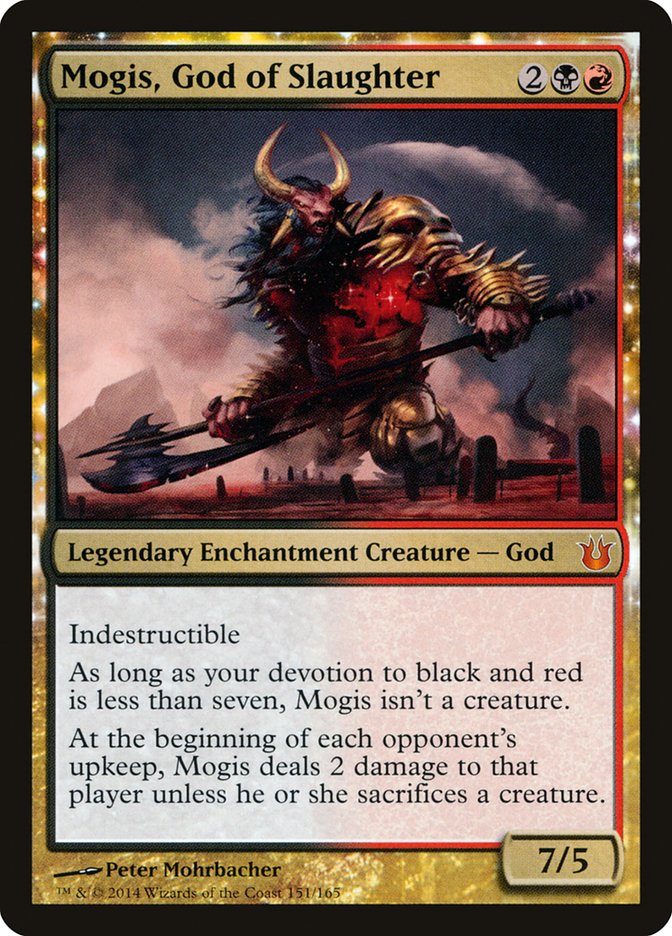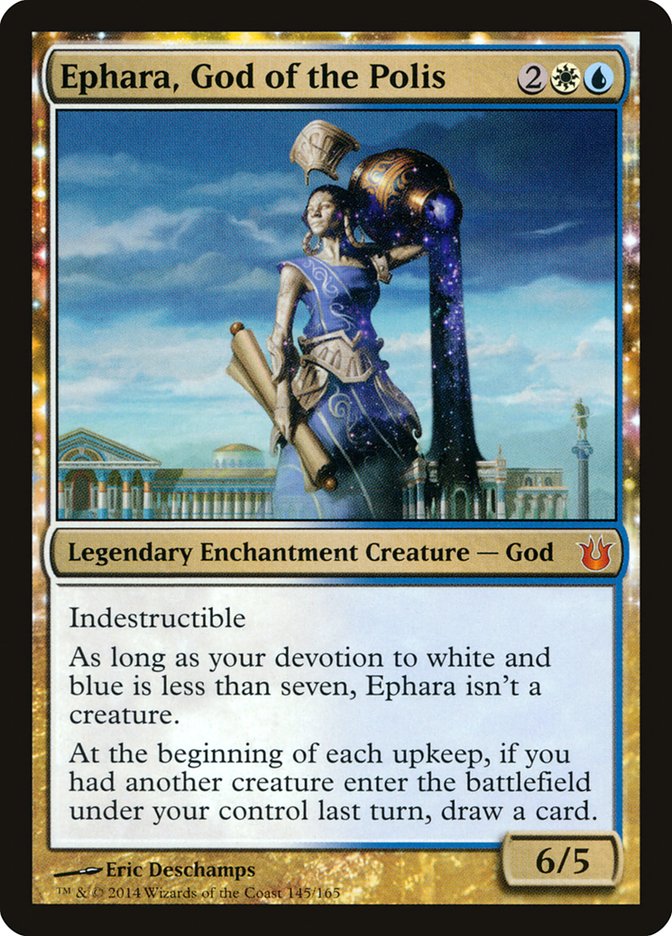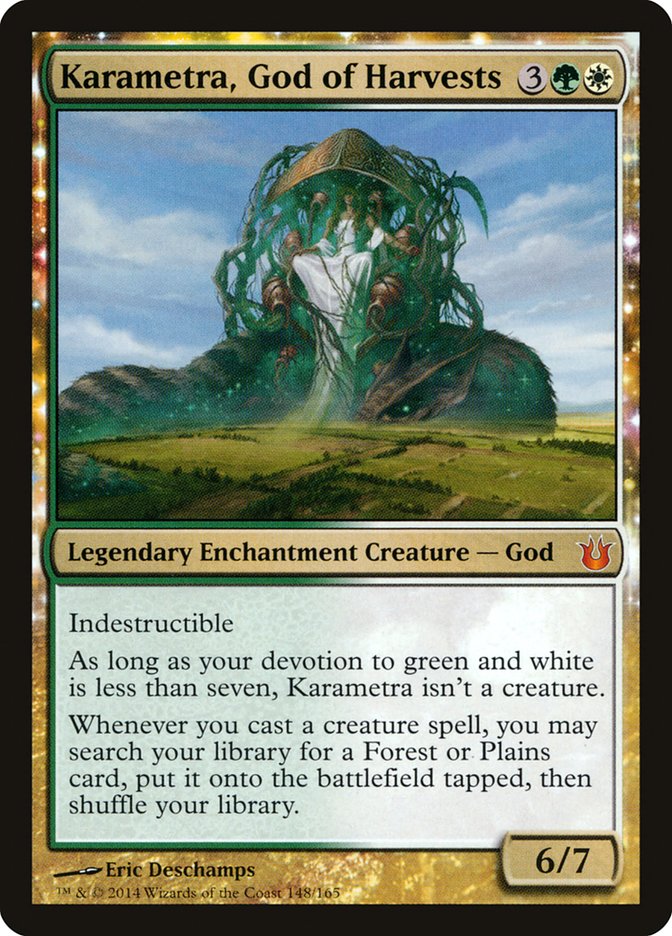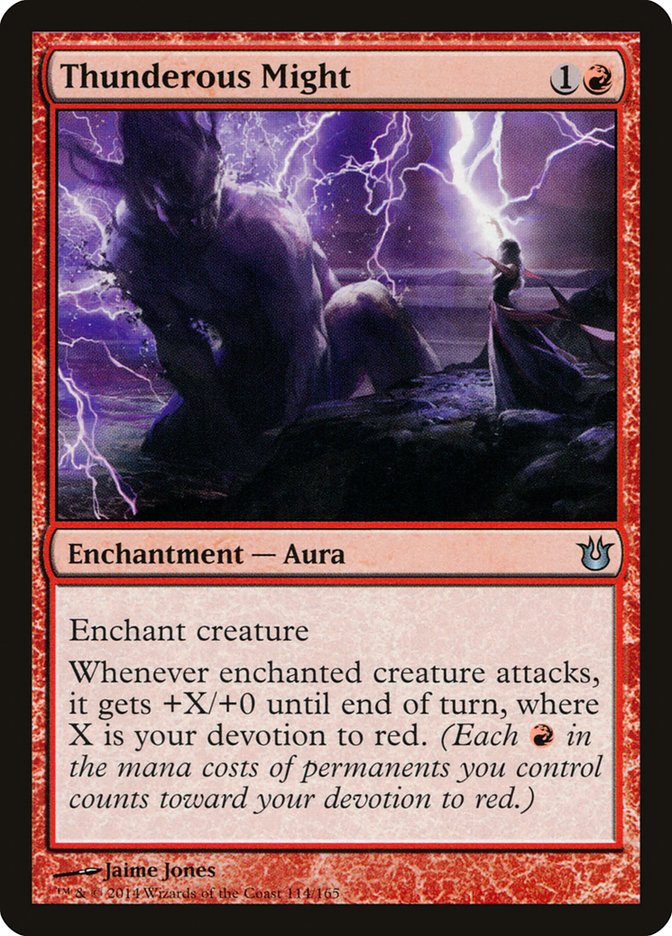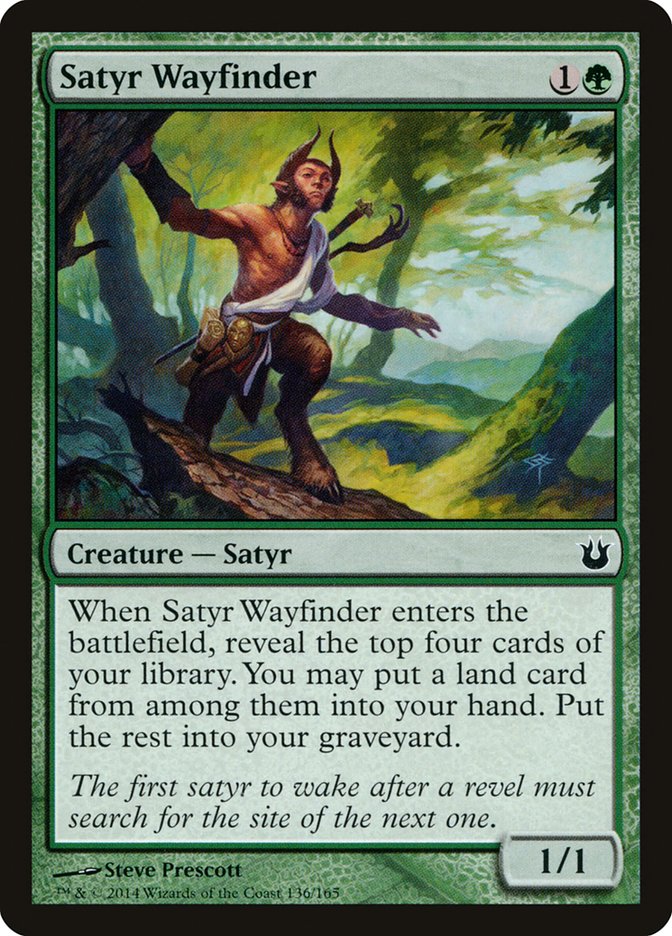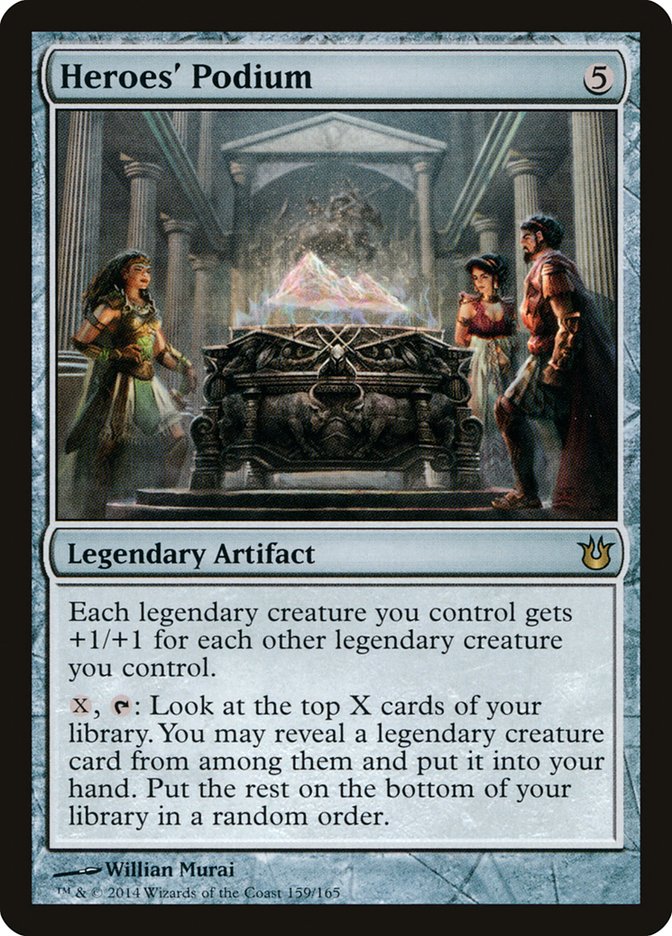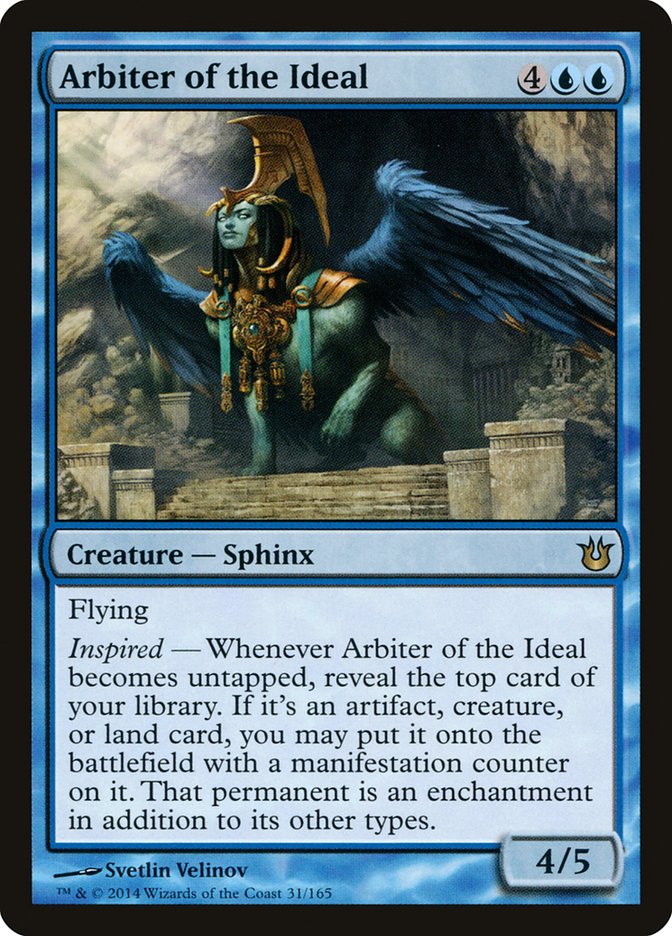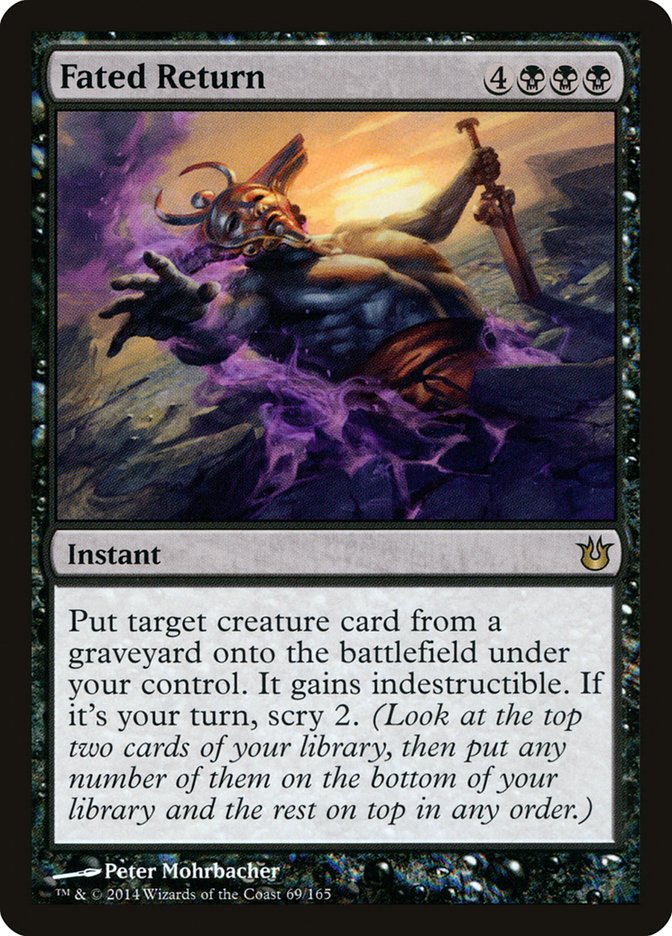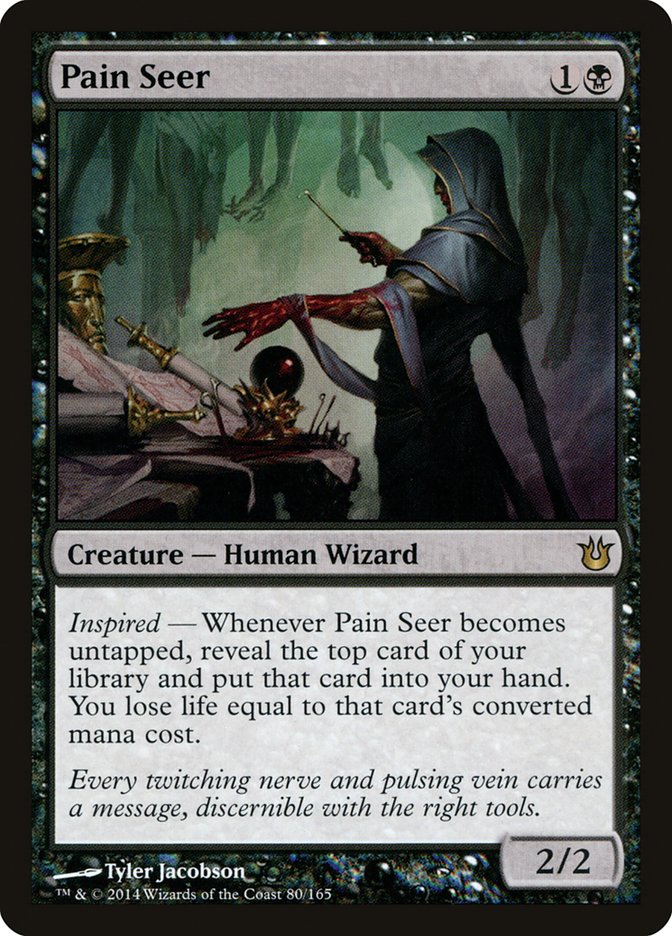"If we knew there was something buried here, would we actually be discovering anything? Or would we just be some schmucks with shovels?"
Born of the Gods is a small set, so it’s already looking at two-thirds as many cards to try to shake things up with as a large expansion. Add to this it is coming on the heels of a format that while radical in its early days quickly settled into a pretty rigid equilibrium. All the usual commentary about you know what and we’re looking at a pretty tough arena for new cards to try to make it.
Born of the Gods obviously has some quality surface-level cards: the Temples; Brimaz, King of Oreskos; Bile Blight; and the like. I have to imagine there is more below the surface, however, and today I’d like to take a look at new decks possible with Born of the Gods. Yeah, nine out of ten are probably not going to make it. The thing is that if you want to succeed you can’t be afraid to fail.
In order to make new decks for the format, we need to know what we’re up against. On Monday in part 1 of my review of Born of the Gods, we covered updates to basically every existing strategy. Today we break new ground. Today we ask what might be possible. Today we try countless experiments.
The first such experiment?
The card in Born of the Gods that gives me the greatest hope. Or perhaps the cards that has surprised me with the greatest hope. Courser of Kruphix is just rad, but it is supposed to be. The card I want to start with today is pretty rad as well, but it is a surprise rad.
Eidolon of Countless Battles gives me hope because I have made white aggro decklists for weeks now looking to take advantage of Brimaz, King of Oreskos and not a one has featured Eidolon of Countless Battles. Oh sure, I had it earmarked to think about later, but an awful lot of rares fall into that category. This guy though—this guy is special.
See, it’s a confusing card, making it easy to overlook. Cards like this are so commonly given the throwaway review of, "Blah-blah-blah description of the card text. Blah-blah-blah could be good with obvious synergy called out in the card text. Blah-blah-blah isn’t terrible, might be good, don’t expect much, but keep an eye on it." What does that even tell us besides the card’s power level is confusing?
The reason I’m excited is because after thinking about the card more I think this one is going to be good. That it wasn’t blindingly obvious on the surface gives me hope that there are more gems to discover in the set.
So why do I think Eidolon of Countless Battles is a sleeper hit?
First, let’s talk about the rate. Scion of the Wild saw fringe play and was basically a green Eidolon of Countless Battles except without bestow and without the ability to count Auras. This card is basically a strictly better version of a fringe-playable tournament card already.
Of course, Scion of the Wild would likely not be playable today. After all, we have Wayfaring Temple, which is basically just better, and it doesn’t see much play. However, Eidolon of Countless Battles does more. A lot more.
For four mana, you basically get a hasty Scion of the Wild (Keldon Warlord for the old school). What I mean by this is that you can threaten your opponent with damage as though the card had haste since you can buff one of your other creatures and attack immediately.
Another example would be Xenagos, God of Revels. We say he has "haste" not because he gives a creature haste (since he can’t target himself) but because he is threatening the opponent with damage as though he had haste because he can buff your Polukranos the turn you play Xenagos. As a result, it’s like you’re attacking for five points of haste (or whatever the power of your biggest creature is).
Eidolon of Countless Battles being a Scion of the Wild that can gain haste if you pay one mana is already kind of appealing, particularly since the card is mono-white (and white is a color that makes lots of dudes pretty easily plus doesn’t usually get haste).
That isn’t even close to the end of it though. When you pay four and bestow him, you are effectively drawing a card. See, your opponent now has to deal with a big threat. How big? Obviously there is a huge range, but Scion of the Wild and other such cards are costed under the assumption that they average out to somewhere between 3/3 and 4/4. By turn 4, you’re more likely to be on the high side (and the Eidolon counts itself), so we’re talking about something like +4/+4 on your Loxodon Smiter or Brimaz, King of Oreskos or whatever.
That is already a potentially game-winning threat that must be dealt with. If it is, however, you’re left with a Scion of the Wild to rebuild with. Yes, it’ll start small if they Supreme Verdict, but you can play more creatures pre-combat and make it large for its first attack. When your creature dies, you’re effectively drawing a card, and that card is a Scion of the Wild that costs zero. It’s even like it has haste!
You know what other card functions like this? Voice of Resurgence. When Voice of Resurgence dies, you basically get a free Scion of the Wild. Eidolon of Countless Battles does the same thing.
So anyway, Eidolon of Countless Battles is my sleeper pick of the set. Let’s take a look at a few decks with it:
Creatures (31)
- 4 Dryad Militant
- 4 Precinct Captain
- 4 Boros Elite
- 4 Daring Skyjek
- 2 Banisher Priest
- 4 Soldier of the Pantheon
- 4 Brimaz, King of Oreskos
- 1 Spirit of the Labyrinth
- 4 Eidolon of Countless Battles
Lands (23)
Spells (6)
Sideboard

This is the one straightforward approach, and whether you are mono-white, W/R, W/B, or whatever, I would add Eidolon of Countless Battles. It’s more power, which we sorely need, and it gives us more resilience to the overwhelming removal packages found in black decks and control decks.
I’ll spare you the Brimaz commentary since there has been no shortage of words spoken on that fella, but his positive synergy with Eidolon of Countless Battles is no joke. Turn 3 Brimaz into turn 4 Eidolon of Countless Battles is absolutely ruthless, and Brave the Elements works so perfectly with both (just be careful not to accidentally make your Eidolon fall off by giving your creatures protection from white when you don’t mean to).
Acolyte’s Reward out of the sideboard is a revolutionary new tool available to white decks. People always underestimate these cards, but when they hit players (like Shining Shoal and Harm’s Way), they generally prove to be tournament worthy. It isn’t as good as Harm’s Way at fighting sweepers since it can only save one creature, but it is generally still a two-for-one against red and a high-impact tempo play.
Another immediate obvious home for Eidolon of Countless Battles is in G/W. Which G/W deck? Take your pick. If you’re playing enough creatures to make Voice of Resurgence a good maindeck card, Eidolon of Countless Battles is interested.
Creatures (25)
- 4 Loxodon Smiter
- 4 Voice of Resurgence
- 4 Fleecemane Lion
- 3 Boon Satyr
- 4 Soldier of the Pantheon
- 3 Brimaz, King of Oreskos
- 3 Eidolon of Countless Battles
Lands (24)
Spells (11)
Sideboard

Maybe we just need to be a faster curve deck, cutting Selesnya Guildgate (and Mutavault) and adding more one-drops. Regardless, the idea is to jam the board with as many midsized fatties as possible. Eidolon of Countless Battles does double duty in this capacity, and I wouldn’t be surprised if some of the threes in the list above are just obviously fours in a couple weeks. Which ones however is far from obvious, so experimenting with a mix will teach us the most the fastest.
I originally jotted down Experiment One and Elvish Mystic, but Brimaz and Eidolon of Countless Battles want us playing a heavier white mana base, making green one-drops unreliable.
Another card I would consider is Spear of Heliod. It’s really not clear where the line should be between Mono-White and G/W Aggro, but that’s a card that looks like it has gotten a lot better with the addition of Born of the Gods. Yes, Bile Blight and Drown in Sorrow are part of it, but it’s also just an increase in the relevance of specific bodies of creatures (and Spear turns around some head-to-head pairings).
One of the most promising developments for G/W is the potential downswing of Thassa. Mono-Blue Devotion has proven a very challenging deck to try to beat with G/W (as evidenced by the eight protection from blue creatures and four Banisher Priests in the list above), but Born of the Gods appears to have helped other strategies more than Thassa. If this proves true, G/W will benefit simply from a less hostile field. It’s hard to know exactly how good G/W will be, but the one thing we know is that World Champion Shahar Shenhar will surely think it’s the best.
Another direction to go with Eidolon of Countless battles is the old-school route. What about G/W Tokens?
Creatures (20)
- 4 Wayfaring Temple
- 4 Experiment One
- 4 Voice of Resurgence
- 4 Elvish Mystic
- 4 Eidolon of Countless Battles
Lands (24)
Spells (16)

Call of the Conclave instead of Fleecemane Lion and Wayfaring Temple instead of Loxodon Smiter? All so we can have Rootborn Defenses instead of Brimaz? This all sounds pretty sketchy, but synergy is synergy. While on the token train, Scion of Vitu-Ghazi is also an option, though if you want to take the curve up that high you probably want to add another land.
Rounding out our G/W creature decks, let’s take a look at a personal favorite of mine:
Creatures (24)
- 4 Voice of Resurgence
- 4 Favored Hoplite
- 4 Fabled Hero
- 2 Brimaz, King of Oreskos
- 4 Hero of Leina Tower
- 3 Eidolon of Countless Battles
- 3 Akroan Skyguard
Lands (23)
Spells (13)

There’s something about Warriors’ Lesson that really calls to me.
Any chance it’s the drawing two cards part of it?
Warriors’ Lesson wants to be paired with flying creatures, but I’m still interested in experimenting with all of these heroic creatures and looking for the right mix. Even Akroan Skyguard might have some value if you’re just shoving all-in on heroic. It’s easy to cast, flying’s what you want, and it pays you in a way you appreciate.
Of course, Hero of Iroas, Phalanx Leader, and Vanguard of Brimaz are all worth considering too, particularly since unlike the Skyguard they don’t involve you getting laughed out of the room. I think the question kind of becomes "are we looking to make one big threat or lots of little threats?" In the meantime, schizophrenic designs like this one are abound.
Hero of Leina Tower is one of the most likely candidates to surprise people and turn out way better than expected. Yeah, you’re often not getting any extra juice out of expensive enablers like Eidolon of Countless Battles or Unflinching Courage, but the card very quickly turns into the biggest body on the board, which is pretty unusual for a one-drop.
It gives you something excellent to do with your extra mana, growing at a more efficient pace then Figure of Destiny (if you actually have a deck full of Gods Willings and the like). If green heroic is good, it’s because of Hero of Leina Tower.
Reap What Is Sown? I don’t know why there’s so much hate for the card. It is an instant-speed Glorious Anthem that triggers all your heroes. Yeah, it doesn’t boost the creatures that come after it, but if you’re playing a dedicated heroic deck, there are few better ways to get multiple triggers. The only reason I haven’t started with more is because there’s such unreal competition at the three spot.
On the topic of heroic, Hidden Strings was the sweetest enabler that never found a good home due to lack of blue incentives to play heroic. Playing U/W was also much more difficult without a Temple. Now we have access to twelve duals plus Meletis Astronomer and Fated Infatuation to draw us into blue.
Creatures (14)
Lands (24)
Spells (22)

This one is more crude than most, but it sure looks fun. Meletis Astronomer draws us a card about 64% of the time but can actually go nuts when combined with Agoraphobia, Hidden Strings, or Ephara’s Enlightenment. Triton Fortune Hunter is a little slower but more reliable at drawing extra cards. Plus the extra lands come into handy since we want to chain tops of cards together when we’re "going off."
The enchantment-based removal is so good here that I could actually see us even adding Domestication or Claustrophobia. The real trick however is going to be sorting between which cards are pulling their weight and which are just too cute (Artisan of Forms, I’m looking at you).
We could also take the same Meletis Astronomer concept and apply it to a white shell:
Creatures (19)
- 4 Battlewise Hoplite
- 4 Favored Hoplite
- 3 Fabled Hero
- 4 Meletis Astronomer
- 4 Eidolon of Countless Battles
Lands (24)
Spells (17)

This list is a little short on heroic enablers, but Gift of Orzhova looks pretty good. Eidolon of Countless Battles is also likely to smash particularly hard.
Ethereal Armor is one of the big winners from Born of the Gods, as we are starting to talk about an awful lot of cards that technically power it up. For instance, this next list is a little silly, but you’ll see what I mean:
Creatures (28)
- 4 Precinct Captain
- 4 Soldier of the Pantheon
- 3 Hopeful Eidolon
- 4 Nyxborn Shieldmate
- 1 Hero of Iroas
- 4 Brimaz, King of Oreskos
- 4 Spirit of the Labyrinth
- 4 Eidolon of Countless Battles
Lands (23)
Spells (9)

A full third of the deck powers Ethereal Armor up, meaning it is often going to be worth +3/+3, +4/+4, or more. Now, I doubt it is worth all the one-power creatures to make Ethereal Armor insane, but the idea is to watch for where we might have enough enchantments anyway. Creatures like Spirit of the Labyrinth, Boon Satyr, and Courser of Kruphix all come to mind as ones that incidentally add enchantments to the board.
One obvious place to go with Ethereal Armor is some kind of hexproof deck:
Creatures (24)
- 4 Gladecover Scout
- 4 Voice of Resurgence
- 4 Ascended Lawmage
- 4 Elvish Mystic
- 4 Witchstalker
- 4 Eidolon of Countless Battles
Lands (24)
Spells (12)

However, the support just isn’t there. None of the hexproof creatures are even close to Invisible Stalker or Geist of Saint Traft, and there really aren’t that many good Auras to put on them besides Ethereal Armor and Unflinching Courage. We really needed something like Rancor to be interested.
Instead, if I were exploring enchantment creatures as a theme, there are two really interesting ones that jump to mind aside from obvious tournament cards like Courser of Kruphix and Spirit of the Labyrinth:
Odunos River Trawler is an actual legit way to get paid for all this nonsense. If you’re deck is full of enchantment creatures, it’s already a three-mana Gravedigger, which is kind of sweet. Then you throw in that it can actually double Gravedigger and now you’re talking about a serious weapon. All you need is something worth Gravediggering.
Enter Chromanticore.
It’s funny to me that Chromanticore would be one of the most underrated cards in the set since it is so obviously similar to Baneslayer Angel. Most people are dismissing it as a joke because of the casting cost, but it is not like it is even that hard to make five-color work. If you can actually cast it, the card is just bonkers.
Start with Baneslayer Angel and give it trample and vigilance instead of +1/+1 and protection from dungeons and dragons. Vigilance is exactly what you want on a Baneslayer Angel, and while I’d rather have the +1/+1 because of things like Mizzium Mortars, we’re at least in the right ballpark (assuming you can cast it).
Where things get really spicy is when you can actually bestow it. Paying two mana to give Baneslayer Angel haste (and vigilance) is already pretty unreal at taking over a game, but it also gives flying and lifelink to the body it is attached to. Basically no matter what you put it on, you’re going to gain a ton of life and completely dominate the board. Then if your opponent can answer your game-winning threat, your consolation prize is a Baneslayer Angel!
If your opponent can deal with a Chromanticore? That is where Odunos comes into play. Now you can Gravedigger your Chromanticore over and over. As long as you protect yourself from cards like Detention Sphere, you are sitting pretty.
Creatures (22)
- 2 Voice of Resurgence
- 2 Polukranos, World Eater
- 4 Sylvan Caryatid
- 4 Boon Satyr
- 4 Chromanticore
- 3 Courser of Kruphix
- 3 Odunos River Trawler
Lands (23)
Spells (15)

This is a fairly good list, but the idea is pretty straightforward. Play lots of enchantment dudes that are good on their own and then abuse them with Odunos (and Dawn to Dusk). Mainly though we just want to cast a lot of Chromanticores and win that way though.
Courser of Kruphix is a particularly appealing "enchantment" creature. While it’s in play, it’s effectively drawing you an extra card 40% of the time (and cards like Nylea’s Presence give you resets). Additionally, you’re gaining almost a life a turn, making the card one of the highest impact three-drops in years. This puts a giant bull’s-eye on its forehead, as opponents are going to bend over backwards to kill it. This plays right into our hands because Odunos doesn’t just get it back; it threatens to get it back again.
I considered Sprit of the Labyrinth, but it’s just too brutal to get stuck with a Nylea’s Presence when the Spirit is in play. My guess is that a few games will reveal the Odunos element is a little cuter than it is effective but that Chromanticore is just the fruity-loop nutter-butters. Honestly, I could see just splashing Chromanticore in some B/G or G/W deck. Playing a Chromanticore for seven just seems so unbeatable for so many decks.
Somewhat in that vein, here is a more "fair" build of Chromanticore:
Creatures (21)
- 3 Scavenging Ooze
- 3 Loxodon Smiter
- 3 Polukranos, World Eater
- 4 Sylvan Caryatid
- 4 Chromanticore
- 4 Courser of Kruphix
Planeswalkers (1)
Lands (24)
Spells (14)

Now we’re basically just a green creature deck with Thoughtseize and some flexible removal spells. Our mana is a little goofy (and going to need some work), but we’ve got plenty of fatties (and could even add Reaper of the Wild for the mondo-combos with Chromanticore). We can drop Chromanticore as a five-drop, which will hopefully live due to Smiters, Coursers, and Polukranos soaking up removal. When we have seven mana, we can go real big and turn anyone into a game-winning threat.
Something I find fascinating about Chromanticore is that its body is a 4/4 when the obvious design is a 5/5. Don’t get me wrong—I think the card is awesome as a 4/4, so a 5/5 is probably absurd. It’s just that this suggests the card was once a 5/5, got tested, and was found to be broken, hence the goofy nerf. If the card was broken at 5/5, I want to know what the deck was.
It’s possible we want to be even less ambitious than the list above. It splashes Abrupt Decay and Detention Sphere, but maybe you’re supposed to stick to just two colors, with the other three being just for Chromanticore? You really don’t need that many duals, and you could max out Chromatic Lanterns. Hell, if that’s not enough for you, you can even play Astral Cornucopia. Four Sylvan Caryatids, four Nylea’s Presences, four Chromatic Lanterns, and a couple Astral Cornucopias and you could play just about all basics if you wanted.
How good is Astral Cornucopia? Everflowing Chalice was pretty unreal; a two-mana artifact that produces mana is much better than a three-mana one that makes any color. Additionally, the four-mana version of Chalice was incredible and common, while the six-mana version of Astral Cornucopia isn’t even that impressive. It also sucks that Astral Cornucopia is so vulnerable to Abrupt Decay and Detention Sphere (in general, not compared to the Lantern, which also is).
That said, the opportunity cost isn’t that high once you have rationalized playing something like Chromatic Lantern. The Lantern is always an awkward card because you can’t count on it to fix your mana, but if you build the rest of your deck to be able to cast your spells, often the Lantern doesn’t do anything for you by the time you can cast it. The idea of being a lock to Manticore on turn 4 is sexy, but the XXX Cornucopia might be sexier still.
Some of the loudest possible build-around cards in Born of the Gods are the new two-color Gods. Needing a devotion of seven to wake up, they are more about their passives than their Theros brethren, but we can use that.
We already discussed Xenagos, God of Revels at length on Monday. He’s my pick for best God in the set, at least partially because of how perfectly he plays in G/R Monsters, a strategy that was already good. Of course, the other part is that Xenagos is just at a very high power level despite costing five.
As for the other four?
Let’s start with Mogis, God of Slaughter.
This one is really confusing to me. Dealing two damage a turn is nice, and a seven power indestructible creature is obviously hot. But he mostly seems like a worse Purphoros, God of the Forge. Purphoros has one less power, but his AoE pump more than makes up for that, particularly since you can pump even when he isn’t awake. The two damage a turn is sort of a wash since Purphoros also sort of does two damage a turn. Then, when it comes to waking up, Purphoros wakes up a little easier (needing just four more instead of five).
This gives us some clues as to where Mogis belongs. Just sliding him into a red devotion deck however doesn’t sound all that hot.
Creatures (28)
- 4 Ash Zealot
- 4 Frostburn Weird
- 3 Hellhole Flailer
- 4 Burning-Tree Emissary
- 4 Boros Reckoner
- 2 Purphoros, God of the Forge
- 3 Stormbreath Dragon
- 2 Fanatic of Mogis
- 2 Mogis, God of Slaughter
Lands (25)
Spells (7)

I’ll admit that Rakdos’s Return is awfully sexy with Nykthos, Shrine to Nyx since we can often assemble ungodly amounts of mana, but I guess I’m just not sold yet on Mogis having enough impact on the board. We will be able to wake him up quite regularly; it’s just confusing to me how similar he is to Purphoros, which is not exactly the type of card you want eight of.
One way to take advantage of Mogis in a way that doesn’t work for Purphoros is to build a deck around him that uses a lot of B/R gold cards. Additionally, if we go a little more beatdown in spirit, we can better capitalize on his direct damage and seven power.
Creatures (27)
- 4 Rakdos Shred-Freak
- 4 Rakdos Cackler
- 4 Hellhole Flailer
- 4 Spike Jester
- 2 Stormbreath Dragon
- 1 Tymaret, the Murder King
- 2 Fanatic of Mogis
- 4 Firedrinker Satyr
- 2 Mogis, God of Slaughter
Lands (25)
Spells (8)

R/B Aggro is less likely to wake him up (due to your creatures dying) but makes better use of his passive ability. It is also dicey trying to mix devotion with removal since every removal spell you play with is sort of like a removal spell someone else played on the creature that would have been in that slot.
Astute readers will surely have realized by this point that Mogis is a minotaur.
Yeah, we’ve seen the artwork. What’s your point?
Maybe it’s a clue! Maybe Mogis is the secret to Minotaur tribal!
Creatures (30)
- 4 Boros Reckoner
- 4 Rageblood Shaman
- 4 Kragma Warcaller
- 4 Fanatic of Mogis
- 4 Deathbellow Raider
- 2 Mogis, God of Slaughter
- 4 Ragemonger
- 4 Felhide Brawler
Lands (24)
Spells (6)

Felhide Brawler doesn’t have a ton going for him on his own, but at least there are three Minotaur "lords." Kragma Warcaller in particular can lead to some pretty big turns.
. . .
One month ago:
"Anything but a mill card, anything at all. Please, please, please let the U/B God do literally anything but mill."
. . .
Making our way around the circle, up next we have the U/B God, Phenax:
Phenax is certainly the most novel of the gods, taking us in a very unusual direction if we want to build around him. It’s not often we look to merge "blue and black creatures with a big toughness" and "dedicated mill."
Here’s an attempt to do just that:
Creatures (16)
- 3 Wall of Frost
- 4 Consuming Aberration
- 4 Nightveil Specter
- 3 Murmuring Phantasm
- 2 Phenax, God of Deception
Planeswalkers (9)
Lands (26)
Spells (9)
Sideboard

Big blue walls form a frontline defense and once we drop Phenax make a pretty fast clock. Bile Blight and Drown in Sorrow are both amusingly strong with walls since your opponent is liable to get stuck playing out a lot more creatures than they normally would have to. It’s basically the Icy Manipulator + Wrath of God experience (assuming we are being generous with our descriptions).
Consuming Aberration is where things get wild. Phenax lets the Aberration tap to double its size, and with Ashiok, Nightmare Weaver and Jace, Memory Adept adding to the mill, we’re often talking about a two-turn clock. Even when you aren’t going to mill them out, Consuming Aberration is often going to be a twenty-power creature that can kill in one hit.
In the highly unlikely event that turbo Phenax isn’t your thing, you can also build U/B Control straight up, taking advantage of Bile Blight and Drown in Sorrow to cover up our lack of Supreme Verdict:
Creatures (2)
Planeswalkers (4)
Lands (26)
Spells (28)
- 3 Opportunity
- 3 Syncopate
- 2 Thoughtseize
- 2 Divination
- 1 Dimir Charm
- 3 Devour Flesh
- 2 Far
- 4 Hero's Downfall
- 4 Dissolve
- 4 Bile Blight
Sideboard

Lots of one-for-ones, some card draw, win with Aetherling. Boring? Maybe, but this is a list that is only interested in winning the championship, not style points.
Continuing our tour de Gods, we come to one of the most promising:
Ephara is a fun one because while confusing in power level at least the output is something we all know we love. Blue and white are also good colors for her since there are lots of good sources for devotion that lead to a slower game, letting you reap the rewards of her passive ability.
We already discussed splashing her in Mono-Blue Devotion alongside Thassa on Monday. Instead, let’s look at the white side of her following:
Creatures (17)
- 4 Precinct Captain
- 1 Angel of Serenity
- 4 Boros Reckoner
- 2 Banisher Priest
- 4 Soldier of the Pantheon
- 2 Ephara, God of the Polis
Planeswalkers (6)
Lands (27)
Spells (10)
Sideboard

Here Ephara is sort of an indestructible planeswalker, drawing an extra card every other turn. She is also deceptively likely to wake up since each Detention Sphere sits around contributing two of the five extra devotion you need. Finally, we get access to some pretty crazy Sphinx’s Revelations due to Nykthos, Shrine to Nyx. Nykthos even powers out fast Elspeths and Angel of Serenitys. The one Steam Vents is to help cast Boros Reckoner on turn 3, and it’s possible the one Island should go the same way.
Remember, Ephara works with Elspeth, letting you draw an extra card each turn. Stick an Aetherling and you’re drawing two extra cards a turn since you can blink the Aetherling on each turn.
Ephara asks you to play an above average number of creatures, but you don’t have to be as devotion centric if you don’t want to be. For instance, here is a U/W deck that isn’t even that far outside the norm:
Creatures (12)
Planeswalkers (7)
Lands (27)
Spells (14)

Even with this few of creatures, we’re going to be drawing extra cards off of Ephara a respectable amount of the time. This build is actually just trying to set up Ephara + Elspeth or Ephara + Aetherling for the full-on blowouts. One theme that is becoming clear however is that Ephara really pushes you away from counterspells. It’s hard to play very many spells at all with her since she so badly wants you to be a creature deck, and with cards like Detention Sphere; Supreme Verdict; Sphinx’s Revelation; Azorius Charm; and Jace, Architect of Thought all vying for spots, Dissolve or Syncopate would come at a high price.
If we’re just trying to break Ephara, turning her into a personal double Howling Mine, we could build a Flash deck around her. The goal is to be able to consistently play creatures on our opponent’s turn so we can trigger Ephara twice.
Creatures (20)
Lands (25)
Spells (15)

It’s a little goofy, but at least none of the cards we’re using are actually "bad." The one Fated Intervention is probably the most suspect card in the list, but it’s worth a shot. Most likely it’s going to quickly turn into an Elspeth, Sun’s Champion.
Finally, last, and quite possibly least, Karametra, God of Harvests:
Okay, maybe Mogis is least of the Gods, but Karametra is still a challenging one since she pays you in something you rarely need once she comes out. It’s a lot of card advantage if you want to play an unreal slow game, maybe in some kind of a Bant Ramp deck, but you have so many good options that it just seems unlikely that this is really the best one. She doesn’t even work with Elspeth or Aetherling the way Ephara does.
Of course, she does have one important thing going for her. She requires devotion to G/W, a color combination ripe with gold cards we actually want to play anyway. Here’s a list that tries to turn her into a six-power indestructible creature (that also helps us cast Angel of Serenity and make Polukranos huge).
Creatures (34)
- 4 Loxodon Smiter
- 3 Angel of Serenity
- 4 Voice of Resurgence
- 4 Elvish Mystic
- 4 Polukranos, World Eater
- 4 Sylvan Caryatid
- 4 Fleecemane Lion
- 3 Karametra, God of Harvests
- 4 Courser of Kruphix
Lands (24)
Spells (2)

Something I find really interesting about Courser of Kruphix is just how many opponents are now going to have enchantments in their maindeck.
- U/W – Detention Sphere
- Mono-U – Thassa, God of the Sea; Bident of Thassa
- Mono-B – Underworld Connections
- R/G – Courser of Kruphix
- W/x Aggro – Spear of Heliod, Spirit of the Labyrinth, Eidolon of Countless Battles
- G/W – Boon Satyr, Eidolon of Countless Battles
Obviously cards like Golgari Charm and Abrupt Decay are maindeckable, but it sure does look like we’re coming up on a format where enchantment removal is very maindeckable, even when it’s just stuff like Revoke Existence and Unravel the Aether. In fact, the biggest thing holding it back is just how many decks there are out there that don’t want to play very many reactive cards because they need to fuel their devotion. Even decks that are not strictly devotion are often rewarded for playing lots of permanents.
For example, check out this W/R Tokens deck:
Creatures (21)
- 4 Precinct Captain
- 2 Sunhome Guildmage
- 2 Ogre Battledriver
- 2 Purphoros, God of the Forge
- 4 Soldier of the Pantheon
- 4 Brimaz, King of Oreskos
- 3 Eidolon of Countless Battles
Planeswalkers (3)
Lands (27)
Spells (9)

We could totally maindeck Revoke Existence, but every reactive card is one less creature to get pumped by Spear of Heliod, Eidolon of Countless Battles, Ogre Battledriver, Purphoros, and Sunhome Guildmage.
Incidentally, Brimaz is pretty sweet with Purphoros, and Eidolon of Countless Battles is effectively an anthem in a token deck, albeit one that is easier to block. The good news is that it gives us additional Supreme Verdict protection and it’s easy for us to quickly make it large after a sweeper.
I don’t know what it looks like yet, but I just wanted to mention this card because so far it looks like it isn’t on anyone’s radar and it does some powerful things. It’s kind of a bad Ethereal Armor, but it might be one that has a better home. Devotion to red is easy to come by, and it doesn’t take much for this to be a Cranial Plating (albeit one that dies).
Dragon Mantle is obviously exciting with it, and Madcap Skills is exactly what you want if you’re on this plan. Akroan Crusader is a respectable target, but red doesn’t really have anything else worth targeting. I guess we could use Arena Athlete, but that sounds pretty loose.
Nyxborn Rollicker and Everflame Eidolon are interesting bestow creatures if we can find a way to abuse them. Everflame Eidolon might just be good on its own, as a 1/1 firebreather for two isn’t that far out of the question and it bestows very cheap. Nyxborn Rollicker you really do have to be abusing, but at least it is extremely cheap.
On the surface, Satyr Wayfinder appears to be a Sylvan Ranger variant that can hit nonbasics but sometimes misses. Sylvan Ranger was playable at times, but we already have Gatecreeper Vine making minimal waves.
Satyr Wayfinder has a second functionality however. It’s also a cheap and efficient way to help stock your graveyard. Combine this with Grisly Salvage and Commune with the Gods and maybe we have something going.
Creatures (26)
- 4 Dreg Mangler
- 4 Elvish Mystic
- 4 Shadowborn Demon
- 2 Polukranos, World Eater
- 4 Nighthowler
- 4 Nemesis of Mortals
- 4 Satyr Wayfinder
Lands (23)
Spells (11)
Sideboard

Here we’re trying to fight through the control and black decks with a relentless stream of big threats, many of which are quite durable. The downside? This is another deck without a lot of room for reactive elements. The proactive game plan it puts together isn’t exactly degenerate, and we are at serious risk of getting flooded.
Here’s an ambitious one!
Figuring out what you’re supposed to do with Heroes’ Podium is the easy part. It says right on there: use legendary creatures. The tricky part is how to actually make that work. After all, it’s not the usual game plan to swarm opponents with lots of different legends.
In order to try to sculpt a game where we actually do this, we should ask the question of how many legends we actually need. What does it take to make Heroes’ Podium "worth it?"
One legend is no effect, and two is a mere +2/+2 worth of stats. What about three? Once we have three legends on the battlefield, we’re getting +6/+6 worth of stats. That’s not breathtaking, but it’s not bad. A fourth creature and we skyrocket up to +12/+12, well worth the trouble.
Interestingly, even when we are short on legends, Heroes’ Podium digs for them, which makes us want to play a little more midrangey than we otherwise would. Additionally, we don’t actually need to draw that many legends since the Podium will find them for us and eventually win the game on its own.
Creatures (29)
- 2 Trostani, Selesnya's Voice
- 2 Aurelia, the Warleader
- 1 Ruric Thar, the Unbowed
- 4 Voice of Resurgence
- 2 Tajic, Blade of the Legion
- 4 Elvish Mystic
- 1 Anax and Cymede
- 4 Polukranos, World Eater
- 4 Sylvan Caryatid
- 1 Xenagos, God of Revels
- 4 Brimaz, King of Oreskos
Planeswalkers (2)
Lands (24)
Spells (5)

Looking at the legends available in Standard at the moment, Naya seemed the clear choice, though blue does offer Daxos and Lavinia. It’s so dangerous to not play many reactive cards since other players are going to have planeswalkers, Gods, and all sorts of busted stuff, but if we can slow the game down, Heroes’ Podium does provide powerful inevitability. It seems particularly effective against black decks, where it will just rip them to shreds and give us a powerful threat every turn.
Maybe I’m weird, but I’m just not that into this guy. Obviously it was designed to be a card that you try to break, but it’s just not ringing that true to me. Maybe there’s some kind of a Springleaf Drum deck. But even then you still have to wait a turn to get paid, and there isn’t exactly a ton of ways to set up the top of your deck.
Yes, you can scry, which helps, but she doesn’t even work with planeswalkers. I don’t know. I guess I’m just gonna chill on this one. I wouldn’t be surprised if there’s something sweet you can do with it. I mean, it’s a huge mana cheat. I guess I just expected more out of this mechanic.
I expected to be inspired . . .
Whelming Wave? Cool card, but there is just not the support for it in Standard at the moment. You get Shipbreaker Kraken and Mutavault, and then what? A bunch of five mana 4/4s and 5/5s with drawbacks?
If there were like three good Krakens, Leviathans, Octopuses, Serpents, or Changelings that cost three or less, maybe we could get something going using Whelming Wave as a tempo card. As it is, this one is more likely a Limited card unless you have some crazy combo that just wants to bounce everything as cheaply as possible. For instance, if you had Archaeomancer and Whelming Wave, you could set up a "soft lock" where you bounce every creature every turn.
Unfortunately, this fails against black removal, permission, burn, haste creatures, flash creatures, discard, and graveyard hate.
I would be remiss if I did not include at least one Grixis list, though sadly Grixis did not gain anything revolutionary. Yeah, we have Temple of Malice for better mana, and that’s nice. We have Bile Blight and Drown in Sorrow, which are not optimized for Grixis but at least options. We have Gild as a playable answer to Thassa. None of this is groundbreaking though.
Anyway, here’s a stab at a build of Grixis that isn’t just a "bad Esper deck."
Planeswalkers (11)
- 1 Jace, Memory Adept
- 4 Jace, Architect of Thought
- 2 Ral Zarek
- 3 Chandra, Pyromaster
- 1 Ashiok, Nightmare Weaver
Lands (26)
Spells (23)
- 3 Thoughtseize
- 2 Divination
- 4 Mizzium Mortars
- 4 Dreadbore
- 2 Rakdos's Return
- 2 Far
- 4 Anger of the Gods
- 2 Gild
Sideboard

Grixis does offer a lot of planeswalkers and a lot of cheap removal spells. Anger of the Gods is not the worst sweeper by any means. Gild does a little to shore up the huge weakness to Gods, which is especially cute when you use the gold coin to help buy a bigger Rakdos’s Return next turn.
We may not have Sphinx’s Revelation, but at least we have eleven walkers to gain some advantage with. We might need a couple of Counterfluxes maindeck, but I thought I’d start with the full-on tapout build.
What card am I saddest to have not yet built with?
What card am I least sad to have not yet built with?
Both are playable, but Fated Return is really exciting to think about, to work with, to explore, while Pain Seer is just this guy that might go in some black aggro deck (but very likely won’t and is just plain overrated due to his resemble to his far more charming cousin Bob).
Born of the Gods is not my favorite set in recent years, but the more I work with it, the more I find beneath the surface. It’s hard to say for sure if any of these gems will prove valuable enough to overthrow the unholy trinity of Thoughtseize / Thassa, God of the Sea / Sphinx’s Revelation, but I’m optimistic that the new world is going to end up a bit different than the last one. And as deckbuilders, it’s our job to find out what that new world is.
Poll: What is the best nonland card in Born of the Gods?
- Bile Blight
- Brimaz, King of Oreskos
- Chromanticore
- Courser of Kruphix
- Drown in Sorrow
- Eidolon of Countless Battles
- Ephara, God of the Polis
- Fated Retribution
- Hero of Leina Tower
- Kiora, the Crashing Wave
- Searing Blood
- Xenagos, God of Revels
- Other???
Patrick Chapin
"The Innovator"

